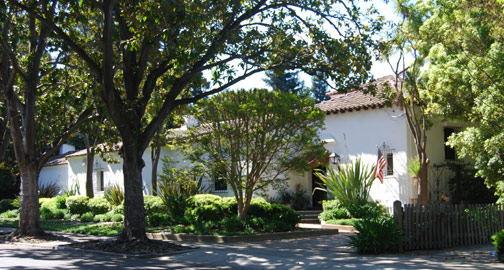 Palo Alto Stanford Heritage
Palo Alto Stanford Heritage 
If there is a coherent architectural image for Palo Alto, it is the Spanish Colonial Revival style seen in the downtown area and scattered throughout its neighborhoods. This architectural style appeared in Palo Alto in 1925 when Santa Barbara designer George Washington Smith (1876–1930) designed a residence for Percy Lawton Pettigrew and Laura Doe Pettigrew.
The Pettigrew family had already established their social rank and fortune when they moved from Pacific Heights to Palo Alto. Percy Pettigrew (1879–1972) graduated from the Lick School of Industrial Arts in 1897 but received his real education from his uncle, the well-known mining engineer, Henry Clay Callahan (1852–1919). His uncle taught the eighteen–year old Percy how to discover and develop bodies of ore and how to manage mines in Australia, China, Mexico, South America, Siberia and in the Mother Lode. According to the California Historical Society, Pettigrew “drove a buckboard over every mile of desert” in Nevada.
In commissioning George Washington Smith to build Casaquerida, as 1336 Cowper Street was called, the Pettigrews chose an architect who is considered the “Father of Spanish Colonial Architecture.” Smith’s career path included stints as a businessman and artist. Born in East Liberty, Pennsylvania on Feb. 22nd (hence his given name), Smith attended Harvard planning to study architecture but was unable to finish his degree because of financial reverses. He then worked in a Philadelphia architectural firm whose paltry pay prompted him to join a bond firm. He was so successful there that he was soon able to abandon the world of business to become a painter, a career he pursued until 1918.
An exhibition of Smith’s art at the Panama Pacific Exposition in 1915 brought him to California where he and his wife, Mary Greenough remained for the duration of WWI. Taken by the charm of Montecito while visiting friends, Smith purchased a lot there and built a house and studio. The house, modeled after Andalusian farmhouses he’d seen in Spain, became an instant success in California and nationally. Smith found that “people were not really as eager to buy my paintings, which I was laboring over, as they were to have a white-washed house just like mine.” Thus, began an architectural career which lasted only 12 years yet produced over 54 houses in architectural styles ranging from Italian, Norman, English Tudor and, even, Byzantine. It was his Spanish Colonial Revival designs which revealed his greatest genius and gained national recognition. Smith, was assisted by his partner and chief draftsman, Lutah Maria Riggs, whom Smith and his wife regarded as a daughter.
Casaquerida was one of only 9 houses built in the Bay Area by George Washington Smith. The 4,981 square foot residence is L–shaped with a two-story section rising at the west end of the front wing. A shallow pitched clay tile roof, of very dark Medium Cordova, was handmade by Gladding, McBean & Co. of San Francisco. Because the house design follows the Spanish tradition of a private shelter from the public, the front façade turns it back to the street presenting only two small, widely spaced and ornately grilled windows and a simple arched doorway. The entry hall forms a corner where the Living Room/Bedroom wing joins the Dining/Kitchen/Pantry wing. A wooden staircase ascends to the bedroom area and has thick upright balusters with spindle-shaped silhouettes. Both the staircase and the grille below it were inspired by ones depicted in Arthur Byne’s book, Spanish Interiors and Furniture. The truss–beamed ceiling supports are incised in unusual and delicate configurations. These and the patterned tile flooring add elegance to the interior.
Casaquerida is the epitome of a walled Mediterranean residence. The closed starkness of the façade contrasts strikingly with the openness of the interior leading to the rear garden. Numerous sets of French windows in the living and dining rooms create the impression that these rooms are part of the beautifully landscaped garden. George Washington Smith was one of the most popular architects in the United States. His houses, which appeared in leading architecture and interior design magazines, influenced local Palo Alto architects to design in the Spanish Colonial style. The current owners of 1336 Cowper Street ensured the future of their residence by having it placed on the National Register of Historic Places in 1980. ©
PAST, August 8, 2014
E-mail us at either webmaster@pastheritage.org or president@pastheritage.org.
![]() Palo Alto Stanford Heritage—Dedicated to the preservation of Palo Alto's historic buildings.
Palo Alto Stanford Heritage—Dedicated to the preservation of Palo Alto's historic buildings.
Copyright © 2015 Palo Alto Stanford Heritage. All rights reserved.